Fashion Weeks: Impact and Trends
VerifiedAdded on 2020/04/21
|12
|2634
|307
AI Summary
This assignment delves into the significant influence of global fashion weeks, particularly focusing on London Fashion Week. It explores the economic impact, marketing strategies, and emerging trends within the fashion industry. The analysis also highlights the risks and challenges faced by fashion businesses, including sustainability concerns and market disruptions. By examining case studies and data, the assignment provides a comprehensive understanding of the current landscape and future directions of fashion weeks.
Contribute Materials
Your contribution can guide someone’s learning journey. Share your
documents today.
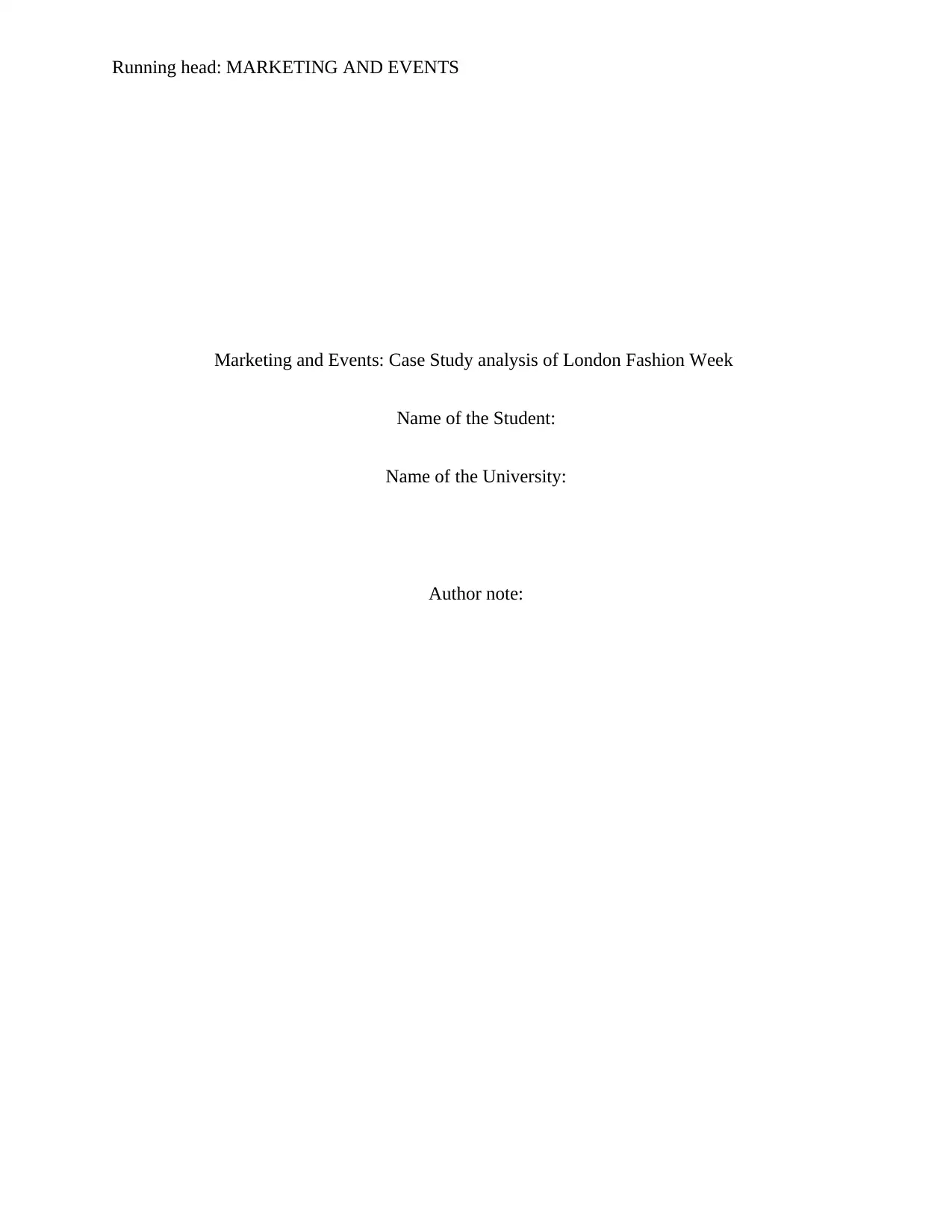
Running head: MARKETING AND EVENTS
Marketing and Events: Case Study analysis of London Fashion Week
Name of the Student:
Name of the University:
Author note:
Marketing and Events: Case Study analysis of London Fashion Week
Name of the Student:
Name of the University:
Author note:
Secure Best Marks with AI Grader
Need help grading? Try our AI Grader for instant feedback on your assignments.
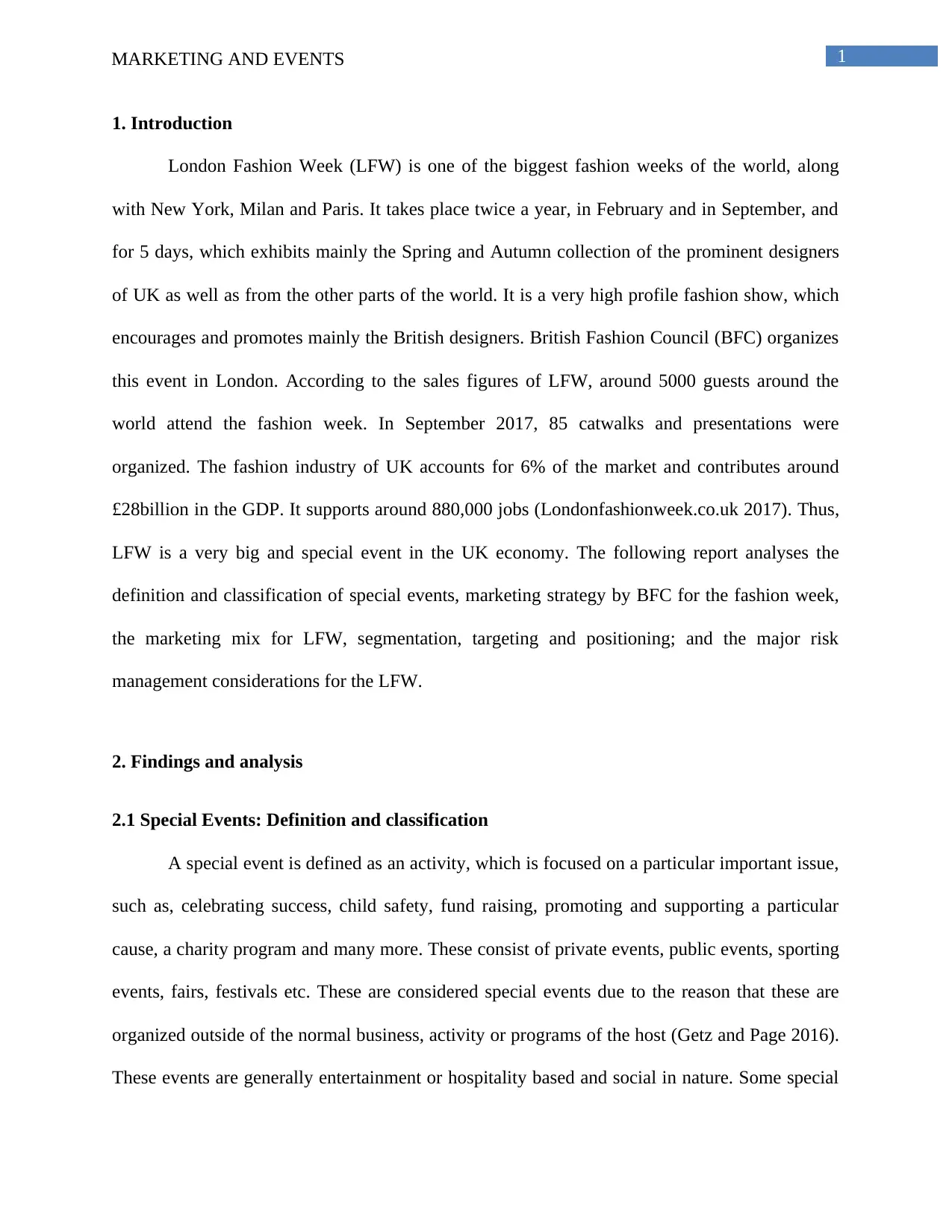
1MARKETING AND EVENTS
1. Introduction
London Fashion Week (LFW) is one of the biggest fashion weeks of the world, along
with New York, Milan and Paris. It takes place twice a year, in February and in September, and
for 5 days, which exhibits mainly the Spring and Autumn collection of the prominent designers
of UK as well as from the other parts of the world. It is a very high profile fashion show, which
encourages and promotes mainly the British designers. British Fashion Council (BFC) organizes
this event in London. According to the sales figures of LFW, around 5000 guests around the
world attend the fashion week. In September 2017, 85 catwalks and presentations were
organized. The fashion industry of UK accounts for 6% of the market and contributes around
£28billion in the GDP. It supports around 880,000 jobs (Londonfashionweek.co.uk 2017). Thus,
LFW is a very big and special event in the UK economy. The following report analyses the
definition and classification of special events, marketing strategy by BFC for the fashion week,
the marketing mix for LFW, segmentation, targeting and positioning; and the major risk
management considerations for the LFW.
2. Findings and analysis
2.1 Special Events: Definition and classification
A special event is defined as an activity, which is focused on a particular important issue,
such as, celebrating success, child safety, fund raising, promoting and supporting a particular
cause, a charity program and many more. These consist of private events, public events, sporting
events, fairs, festivals etc. These are considered special events due to the reason that these are
organized outside of the normal business, activity or programs of the host (Getz and Page 2016).
These events are generally entertainment or hospitality based and social in nature. Some special
1. Introduction
London Fashion Week (LFW) is one of the biggest fashion weeks of the world, along
with New York, Milan and Paris. It takes place twice a year, in February and in September, and
for 5 days, which exhibits mainly the Spring and Autumn collection of the prominent designers
of UK as well as from the other parts of the world. It is a very high profile fashion show, which
encourages and promotes mainly the British designers. British Fashion Council (BFC) organizes
this event in London. According to the sales figures of LFW, around 5000 guests around the
world attend the fashion week. In September 2017, 85 catwalks and presentations were
organized. The fashion industry of UK accounts for 6% of the market and contributes around
£28billion in the GDP. It supports around 880,000 jobs (Londonfashionweek.co.uk 2017). Thus,
LFW is a very big and special event in the UK economy. The following report analyses the
definition and classification of special events, marketing strategy by BFC for the fashion week,
the marketing mix for LFW, segmentation, targeting and positioning; and the major risk
management considerations for the LFW.
2. Findings and analysis
2.1 Special Events: Definition and classification
A special event is defined as an activity, which is focused on a particular important issue,
such as, celebrating success, child safety, fund raising, promoting and supporting a particular
cause, a charity program and many more. These consist of private events, public events, sporting
events, fairs, festivals etc. These are considered special events due to the reason that these are
organized outside of the normal business, activity or programs of the host (Getz and Page 2016).
These events are generally entertainment or hospitality based and social in nature. Some special
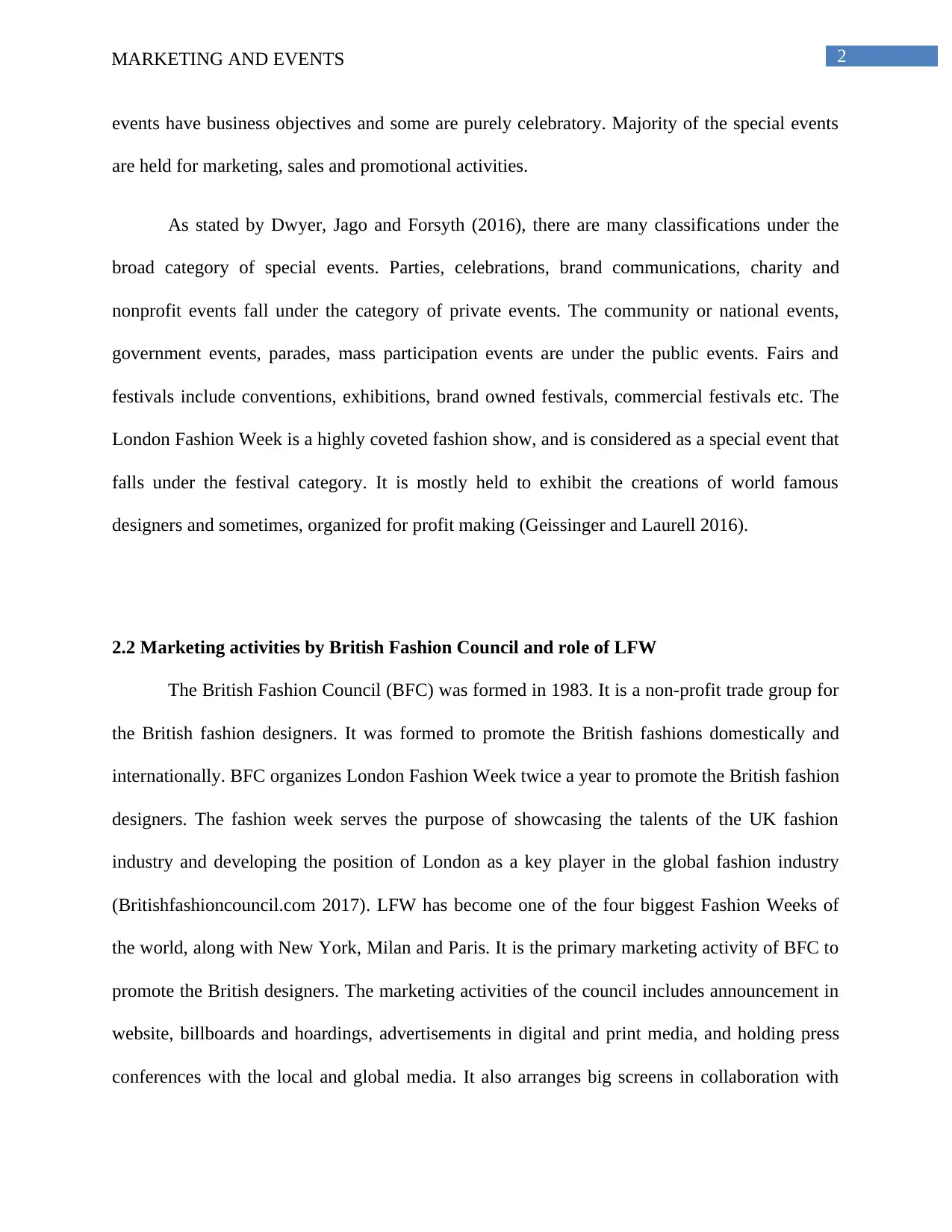
2MARKETING AND EVENTS
events have business objectives and some are purely celebratory. Majority of the special events
are held for marketing, sales and promotional activities.
As stated by Dwyer, Jago and Forsyth (2016), there are many classifications under the
broad category of special events. Parties, celebrations, brand communications, charity and
nonprofit events fall under the category of private events. The community or national events,
government events, parades, mass participation events are under the public events. Fairs and
festivals include conventions, exhibitions, brand owned festivals, commercial festivals etc. The
London Fashion Week is a highly coveted fashion show, and is considered as a special event that
falls under the festival category. It is mostly held to exhibit the creations of world famous
designers and sometimes, organized for profit making (Geissinger and Laurell 2016).
2.2 Marketing activities by British Fashion Council and role of LFW
The British Fashion Council (BFC) was formed in 1983. It is a non-profit trade group for
the British fashion designers. It was formed to promote the British fashions domestically and
internationally. BFC organizes London Fashion Week twice a year to promote the British fashion
designers. The fashion week serves the purpose of showcasing the talents of the UK fashion
industry and developing the position of London as a key player in the global fashion industry
(Britishfashioncouncil.com 2017). LFW has become one of the four biggest Fashion Weeks of
the world, along with New York, Milan and Paris. It is the primary marketing activity of BFC to
promote the British designers. The marketing activities of the council includes announcement in
website, billboards and hoardings, advertisements in digital and print media, and holding press
conferences with the local and global media. It also arranges big screens in collaboration with
events have business objectives and some are purely celebratory. Majority of the special events
are held for marketing, sales and promotional activities.
As stated by Dwyer, Jago and Forsyth (2016), there are many classifications under the
broad category of special events. Parties, celebrations, brand communications, charity and
nonprofit events fall under the category of private events. The community or national events,
government events, parades, mass participation events are under the public events. Fairs and
festivals include conventions, exhibitions, brand owned festivals, commercial festivals etc. The
London Fashion Week is a highly coveted fashion show, and is considered as a special event that
falls under the festival category. It is mostly held to exhibit the creations of world famous
designers and sometimes, organized for profit making (Geissinger and Laurell 2016).
2.2 Marketing activities by British Fashion Council and role of LFW
The British Fashion Council (BFC) was formed in 1983. It is a non-profit trade group for
the British fashion designers. It was formed to promote the British fashions domestically and
internationally. BFC organizes London Fashion Week twice a year to promote the British fashion
designers. The fashion week serves the purpose of showcasing the talents of the UK fashion
industry and developing the position of London as a key player in the global fashion industry
(Britishfashioncouncil.com 2017). LFW has become one of the four biggest Fashion Weeks of
the world, along with New York, Milan and Paris. It is the primary marketing activity of BFC to
promote the British designers. The marketing activities of the council includes announcement in
website, billboards and hoardings, advertisements in digital and print media, and holding press
conferences with the local and global media. It also arranges big screens in collaboration with
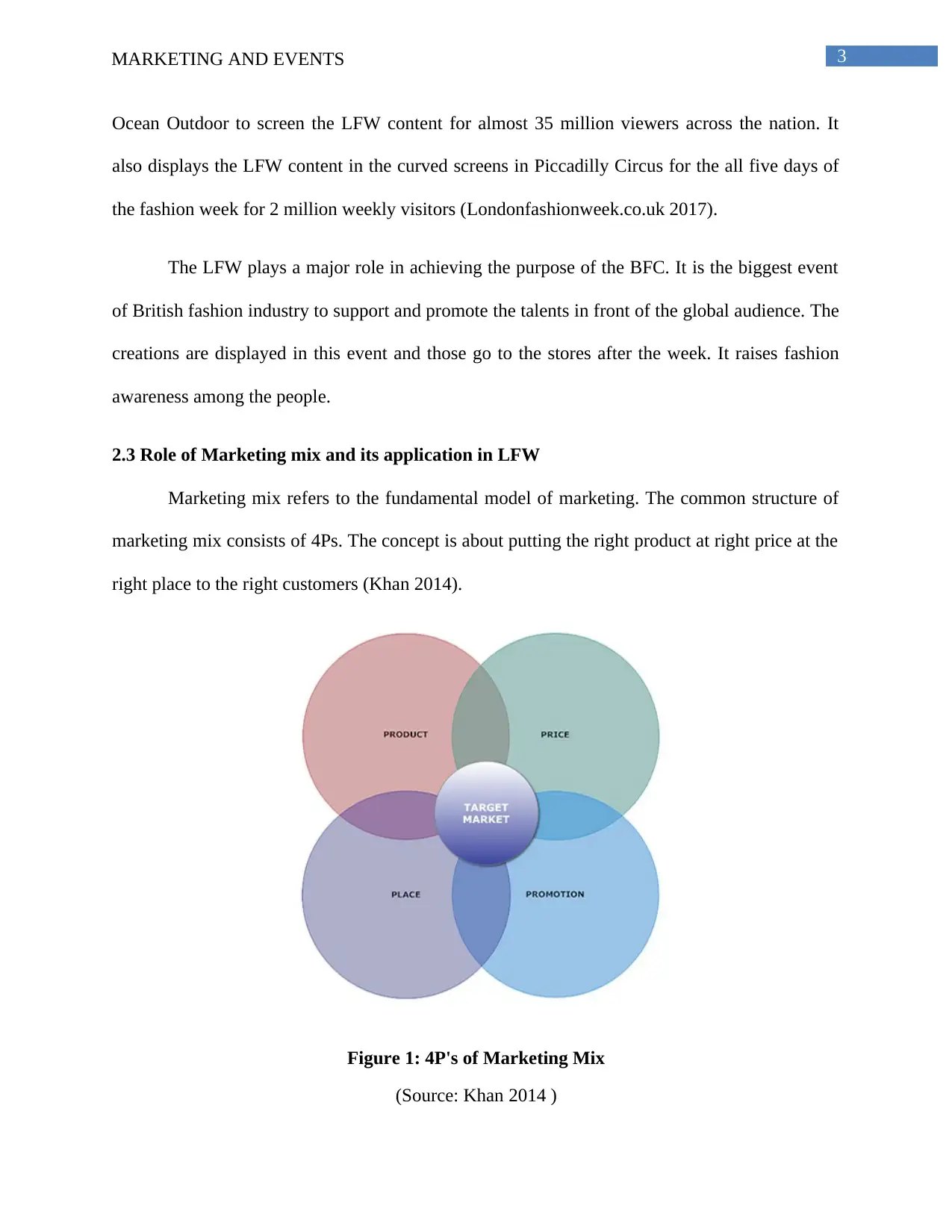
3MARKETING AND EVENTS
Ocean Outdoor to screen the LFW content for almost 35 million viewers across the nation. It
also displays the LFW content in the curved screens in Piccadilly Circus for the all five days of
the fashion week for 2 million weekly visitors (Londonfashionweek.co.uk 2017).
The LFW plays a major role in achieving the purpose of the BFC. It is the biggest event
of British fashion industry to support and promote the talents in front of the global audience. The
creations are displayed in this event and those go to the stores after the week. It raises fashion
awareness among the people.
2.3 Role of Marketing mix and its application in LFW
Marketing mix refers to the fundamental model of marketing. The common structure of
marketing mix consists of 4Ps. The concept is about putting the right product at right price at the
right place to the right customers (Khan 2014).
Figure 1: 4P's of Marketing Mix
(Source: Khan 2014 )
Ocean Outdoor to screen the LFW content for almost 35 million viewers across the nation. It
also displays the LFW content in the curved screens in Piccadilly Circus for the all five days of
the fashion week for 2 million weekly visitors (Londonfashionweek.co.uk 2017).
The LFW plays a major role in achieving the purpose of the BFC. It is the biggest event
of British fashion industry to support and promote the talents in front of the global audience. The
creations are displayed in this event and those go to the stores after the week. It raises fashion
awareness among the people.
2.3 Role of Marketing mix and its application in LFW
Marketing mix refers to the fundamental model of marketing. The common structure of
marketing mix consists of 4Ps. The concept is about putting the right product at right price at the
right place to the right customers (Khan 2014).
Figure 1: 4P's of Marketing Mix
(Source: Khan 2014 )
Secure Best Marks with AI Grader
Need help grading? Try our AI Grader for instant feedback on your assignments.
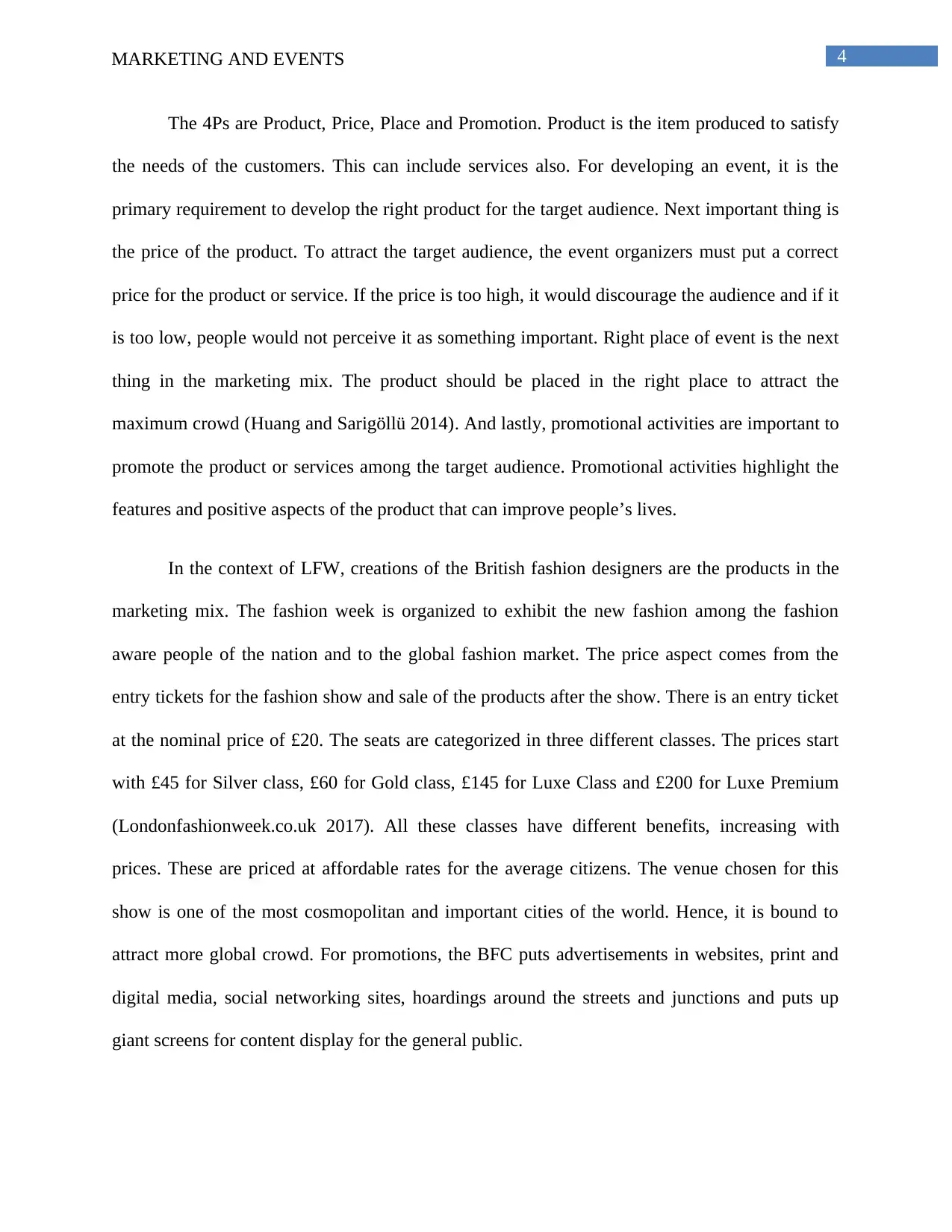
4MARKETING AND EVENTS
The 4Ps are Product, Price, Place and Promotion. Product is the item produced to satisfy
the needs of the customers. This can include services also. For developing an event, it is the
primary requirement to develop the right product for the target audience. Next important thing is
the price of the product. To attract the target audience, the event organizers must put a correct
price for the product or service. If the price is too high, it would discourage the audience and if it
is too low, people would not perceive it as something important. Right place of event is the next
thing in the marketing mix. The product should be placed in the right place to attract the
maximum crowd (Huang and Sarigöllü 2014). And lastly, promotional activities are important to
promote the product or services among the target audience. Promotional activities highlight the
features and positive aspects of the product that can improve people’s lives.
In the context of LFW, creations of the British fashion designers are the products in the
marketing mix. The fashion week is organized to exhibit the new fashion among the fashion
aware people of the nation and to the global fashion market. The price aspect comes from the
entry tickets for the fashion show and sale of the products after the show. There is an entry ticket
at the nominal price of £20. The seats are categorized in three different classes. The prices start
with £45 for Silver class, £60 for Gold class, £145 for Luxe Class and £200 for Luxe Premium
(Londonfashionweek.co.uk 2017). All these classes have different benefits, increasing with
prices. These are priced at affordable rates for the average citizens. The venue chosen for this
show is one of the most cosmopolitan and important cities of the world. Hence, it is bound to
attract more global crowd. For promotions, the BFC puts advertisements in websites, print and
digital media, social networking sites, hoardings around the streets and junctions and puts up
giant screens for content display for the general public.
The 4Ps are Product, Price, Place and Promotion. Product is the item produced to satisfy
the needs of the customers. This can include services also. For developing an event, it is the
primary requirement to develop the right product for the target audience. Next important thing is
the price of the product. To attract the target audience, the event organizers must put a correct
price for the product or service. If the price is too high, it would discourage the audience and if it
is too low, people would not perceive it as something important. Right place of event is the next
thing in the marketing mix. The product should be placed in the right place to attract the
maximum crowd (Huang and Sarigöllü 2014). And lastly, promotional activities are important to
promote the product or services among the target audience. Promotional activities highlight the
features and positive aspects of the product that can improve people’s lives.
In the context of LFW, creations of the British fashion designers are the products in the
marketing mix. The fashion week is organized to exhibit the new fashion among the fashion
aware people of the nation and to the global fashion market. The price aspect comes from the
entry tickets for the fashion show and sale of the products after the show. There is an entry ticket
at the nominal price of £20. The seats are categorized in three different classes. The prices start
with £45 for Silver class, £60 for Gold class, £145 for Luxe Class and £200 for Luxe Premium
(Londonfashionweek.co.uk 2017). All these classes have different benefits, increasing with
prices. These are priced at affordable rates for the average citizens. The venue chosen for this
show is one of the most cosmopolitan and important cities of the world. Hence, it is bound to
attract more global crowd. For promotions, the BFC puts advertisements in websites, print and
digital media, social networking sites, hoardings around the streets and junctions and puts up
giant screens for content display for the general public.
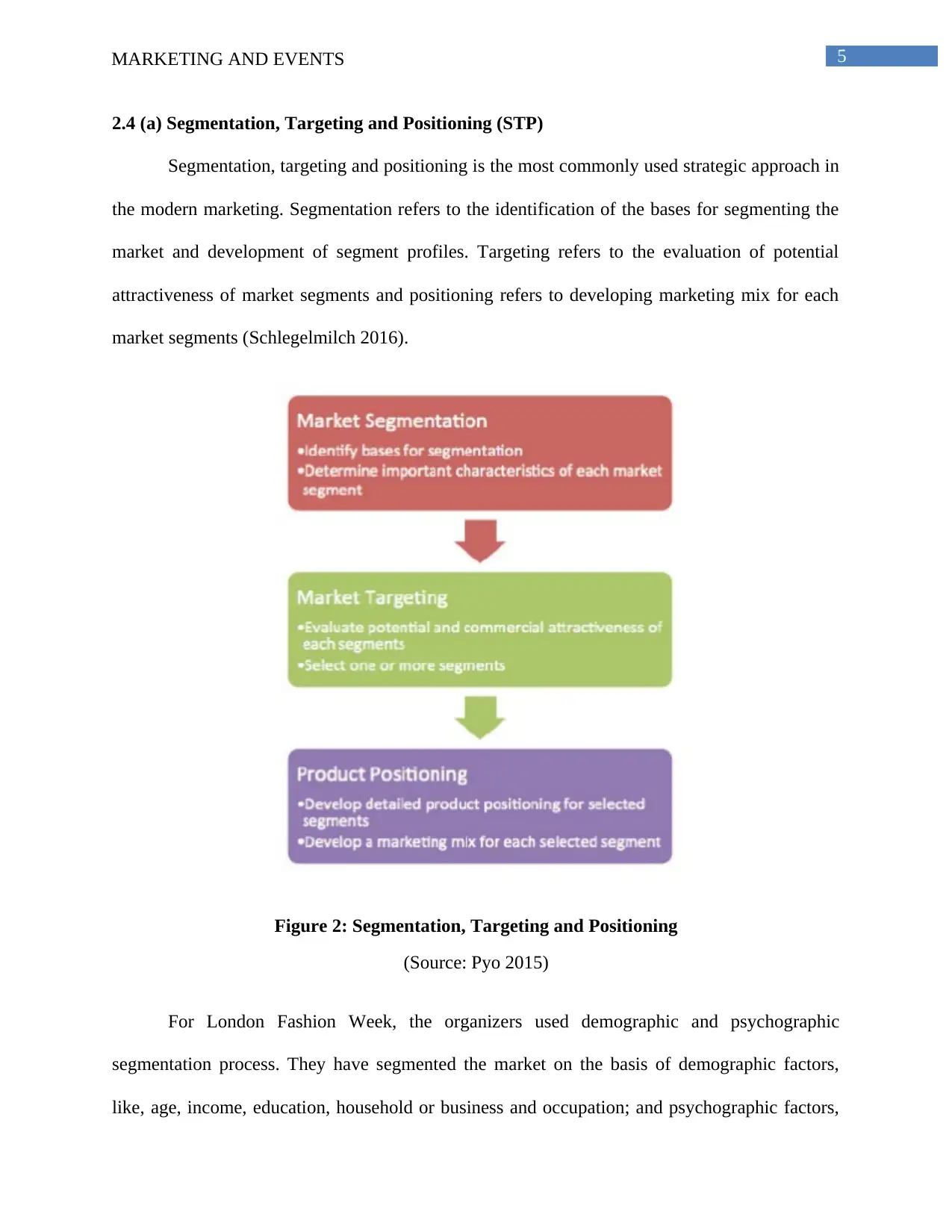
5MARKETING AND EVENTS
2.4 (a) Segmentation, Targeting and Positioning (STP)
Segmentation, targeting and positioning is the most commonly used strategic approach in
the modern marketing. Segmentation refers to the identification of the bases for segmenting the
market and development of segment profiles. Targeting refers to the evaluation of potential
attractiveness of market segments and positioning refers to developing marketing mix for each
market segments (Schlegelmilch 2016).
Figure 2: Segmentation, Targeting and Positioning
(Source: Pyo 2015)
For London Fashion Week, the organizers used demographic and psychographic
segmentation process. They have segmented the market on the basis of demographic factors,
like, age, income, education, household or business and occupation; and psychographic factors,
2.4 (a) Segmentation, Targeting and Positioning (STP)
Segmentation, targeting and positioning is the most commonly used strategic approach in
the modern marketing. Segmentation refers to the identification of the bases for segmenting the
market and development of segment profiles. Targeting refers to the evaluation of potential
attractiveness of market segments and positioning refers to developing marketing mix for each
market segments (Schlegelmilch 2016).
Figure 2: Segmentation, Targeting and Positioning
(Source: Pyo 2015)
For London Fashion Week, the organizers used demographic and psychographic
segmentation process. They have segmented the market on the basis of demographic factors,
like, age, income, education, household or business and occupation; and psychographic factors,
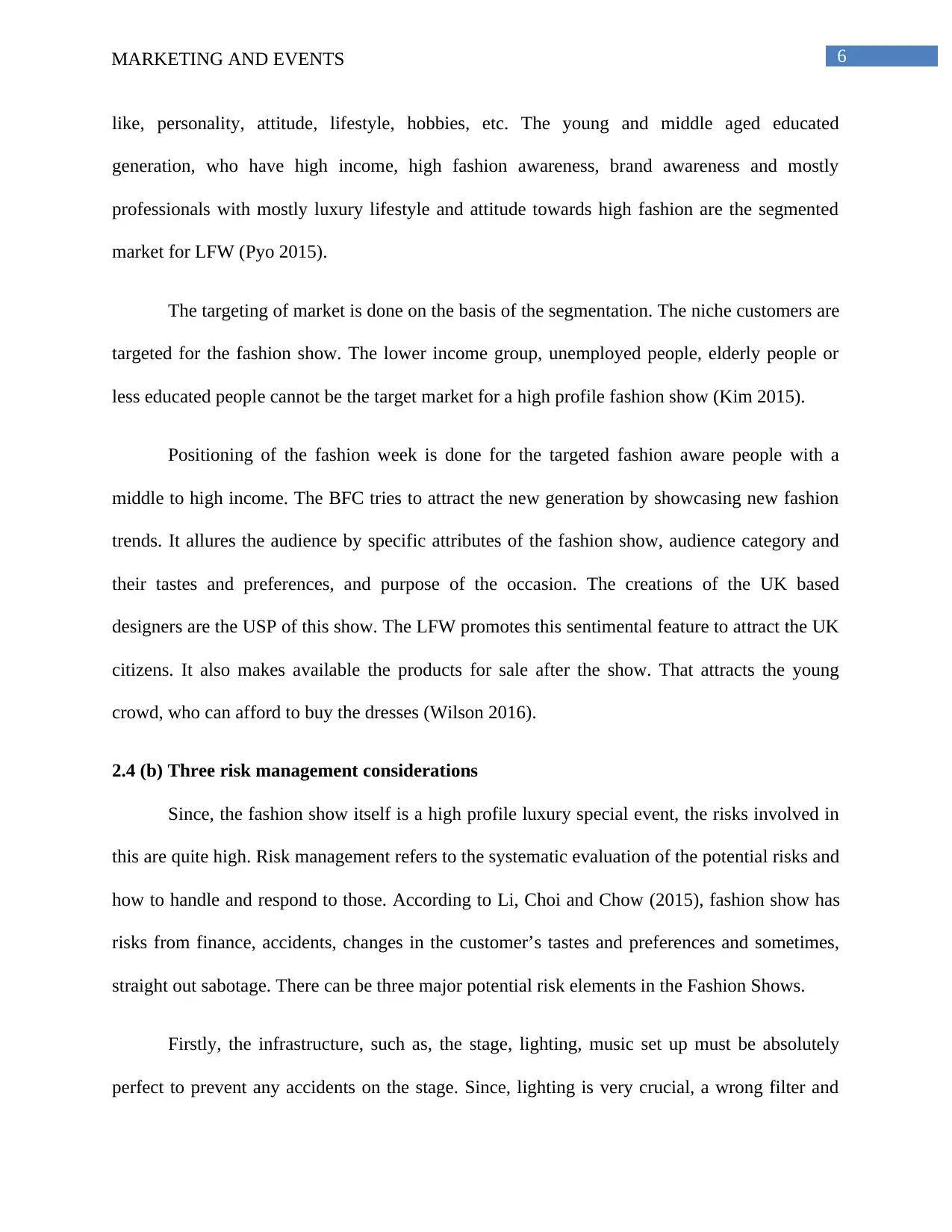
6MARKETING AND EVENTS
like, personality, attitude, lifestyle, hobbies, etc. The young and middle aged educated
generation, who have high income, high fashion awareness, brand awareness and mostly
professionals with mostly luxury lifestyle and attitude towards high fashion are the segmented
market for LFW (Pyo 2015).
The targeting of market is done on the basis of the segmentation. The niche customers are
targeted for the fashion show. The lower income group, unemployed people, elderly people or
less educated people cannot be the target market for a high profile fashion show (Kim 2015).
Positioning of the fashion week is done for the targeted fashion aware people with a
middle to high income. The BFC tries to attract the new generation by showcasing new fashion
trends. It allures the audience by specific attributes of the fashion show, audience category and
their tastes and preferences, and purpose of the occasion. The creations of the UK based
designers are the USP of this show. The LFW promotes this sentimental feature to attract the UK
citizens. It also makes available the products for sale after the show. That attracts the young
crowd, who can afford to buy the dresses (Wilson 2016).
2.4 (b) Three risk management considerations
Since, the fashion show itself is a high profile luxury special event, the risks involved in
this are quite high. Risk management refers to the systematic evaluation of the potential risks and
how to handle and respond to those. According to Li, Choi and Chow (2015), fashion show has
risks from finance, accidents, changes in the customer’s tastes and preferences and sometimes,
straight out sabotage. There can be three major potential risk elements in the Fashion Shows.
Firstly, the infrastructure, such as, the stage, lighting, music set up must be absolutely
perfect to prevent any accidents on the stage. Since, lighting is very crucial, a wrong filter and
like, personality, attitude, lifestyle, hobbies, etc. The young and middle aged educated
generation, who have high income, high fashion awareness, brand awareness and mostly
professionals with mostly luxury lifestyle and attitude towards high fashion are the segmented
market for LFW (Pyo 2015).
The targeting of market is done on the basis of the segmentation. The niche customers are
targeted for the fashion show. The lower income group, unemployed people, elderly people or
less educated people cannot be the target market for a high profile fashion show (Kim 2015).
Positioning of the fashion week is done for the targeted fashion aware people with a
middle to high income. The BFC tries to attract the new generation by showcasing new fashion
trends. It allures the audience by specific attributes of the fashion show, audience category and
their tastes and preferences, and purpose of the occasion. The creations of the UK based
designers are the USP of this show. The LFW promotes this sentimental feature to attract the UK
citizens. It also makes available the products for sale after the show. That attracts the young
crowd, who can afford to buy the dresses (Wilson 2016).
2.4 (b) Three risk management considerations
Since, the fashion show itself is a high profile luxury special event, the risks involved in
this are quite high. Risk management refers to the systematic evaluation of the potential risks and
how to handle and respond to those. According to Li, Choi and Chow (2015), fashion show has
risks from finance, accidents, changes in the customer’s tastes and preferences and sometimes,
straight out sabotage. There can be three major potential risk elements in the Fashion Shows.
Firstly, the infrastructure, such as, the stage, lighting, music set up must be absolutely
perfect to prevent any accidents on the stage. Since, lighting is very crucial, a wrong filter and
Paraphrase This Document
Need a fresh take? Get an instant paraphrase of this document with our AI Paraphraser
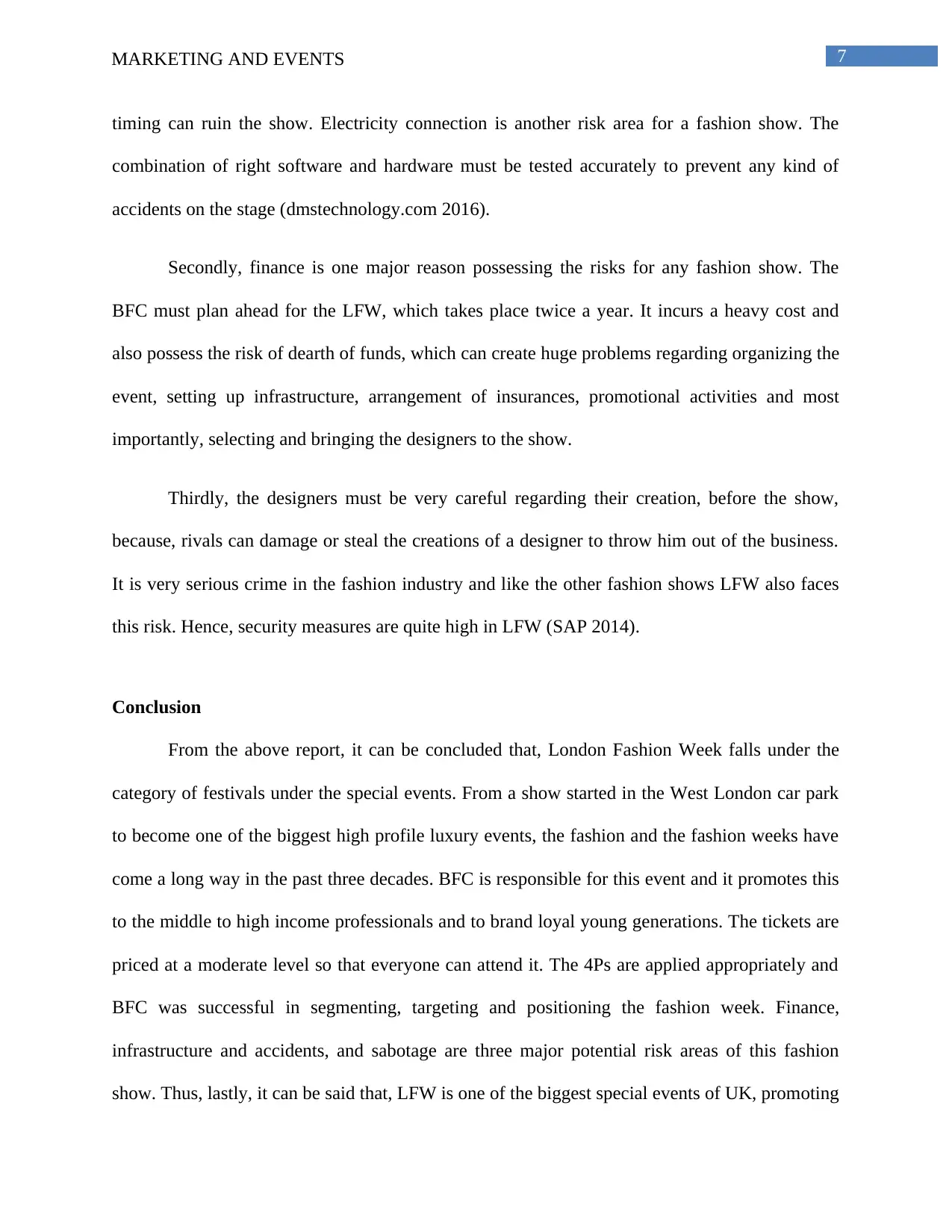
7MARKETING AND EVENTS
timing can ruin the show. Electricity connection is another risk area for a fashion show. The
combination of right software and hardware must be tested accurately to prevent any kind of
accidents on the stage (dmstechnology.com 2016).
Secondly, finance is one major reason possessing the risks for any fashion show. The
BFC must plan ahead for the LFW, which takes place twice a year. It incurs a heavy cost and
also possess the risk of dearth of funds, which can create huge problems regarding organizing the
event, setting up infrastructure, arrangement of insurances, promotional activities and most
importantly, selecting and bringing the designers to the show.
Thirdly, the designers must be very careful regarding their creation, before the show,
because, rivals can damage or steal the creations of a designer to throw him out of the business.
It is very serious crime in the fashion industry and like the other fashion shows LFW also faces
this risk. Hence, security measures are quite high in LFW (SAP 2014).
Conclusion
From the above report, it can be concluded that, London Fashion Week falls under the
category of festivals under the special events. From a show started in the West London car park
to become one of the biggest high profile luxury events, the fashion and the fashion weeks have
come a long way in the past three decades. BFC is responsible for this event and it promotes this
to the middle to high income professionals and to brand loyal young generations. The tickets are
priced at a moderate level so that everyone can attend it. The 4Ps are applied appropriately and
BFC was successful in segmenting, targeting and positioning the fashion week. Finance,
infrastructure and accidents, and sabotage are three major potential risk areas of this fashion
show. Thus, lastly, it can be said that, LFW is one of the biggest special events of UK, promoting
timing can ruin the show. Electricity connection is another risk area for a fashion show. The
combination of right software and hardware must be tested accurately to prevent any kind of
accidents on the stage (dmstechnology.com 2016).
Secondly, finance is one major reason possessing the risks for any fashion show. The
BFC must plan ahead for the LFW, which takes place twice a year. It incurs a heavy cost and
also possess the risk of dearth of funds, which can create huge problems regarding organizing the
event, setting up infrastructure, arrangement of insurances, promotional activities and most
importantly, selecting and bringing the designers to the show.
Thirdly, the designers must be very careful regarding their creation, before the show,
because, rivals can damage or steal the creations of a designer to throw him out of the business.
It is very serious crime in the fashion industry and like the other fashion shows LFW also faces
this risk. Hence, security measures are quite high in LFW (SAP 2014).
Conclusion
From the above report, it can be concluded that, London Fashion Week falls under the
category of festivals under the special events. From a show started in the West London car park
to become one of the biggest high profile luxury events, the fashion and the fashion weeks have
come a long way in the past three decades. BFC is responsible for this event and it promotes this
to the middle to high income professionals and to brand loyal young generations. The tickets are
priced at a moderate level so that everyone can attend it. The 4Ps are applied appropriately and
BFC was successful in segmenting, targeting and positioning the fashion week. Finance,
infrastructure and accidents, and sabotage are three major potential risk areas of this fashion
show. Thus, lastly, it can be said that, LFW is one of the biggest special events of UK, promoting

8MARKETING AND EVENTS
the British talents of the fashion industry to the world, and contributing significantly in the UK
economy.
the British talents of the fashion industry to the world, and contributing significantly in the UK
economy.
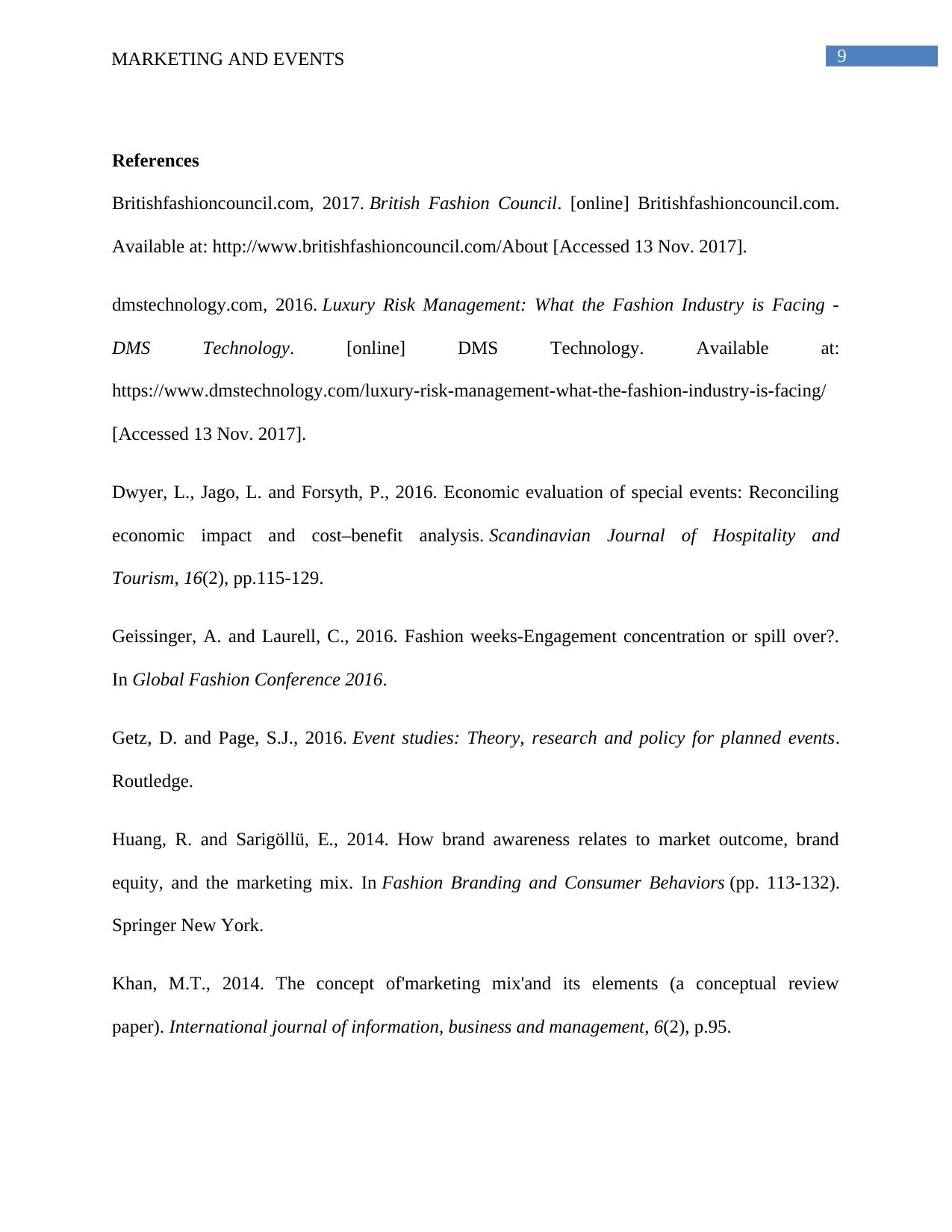
9MARKETING AND EVENTS
References
Britishfashioncouncil.com, 2017. British Fashion Council. [online] Britishfashioncouncil.com.
Available at: http://www.britishfashioncouncil.com/About [Accessed 13 Nov. 2017].
dmstechnology.com, 2016. Luxury Risk Management: What the Fashion Industry is Facing -
DMS Technology. [online] DMS Technology. Available at:
https://www.dmstechnology.com/luxury-risk-management-what-the-fashion-industry-is-facing/
[Accessed 13 Nov. 2017].
Dwyer, L., Jago, L. and Forsyth, P., 2016. Economic evaluation of special events: Reconciling
economic impact and cost–benefit analysis. Scandinavian Journal of Hospitality and
Tourism, 16(2), pp.115-129.
Geissinger, A. and Laurell, C., 2016. Fashion weeks-Engagement concentration or spill over?.
In Global Fashion Conference 2016.
Getz, D. and Page, S.J., 2016. Event studies: Theory, research and policy for planned events.
Routledge.
Huang, R. and Sarigöllü, E., 2014. How brand awareness relates to market outcome, brand
equity, and the marketing mix. In Fashion Branding and Consumer Behaviors (pp. 113-132).
Springer New York.
Khan, M.T., 2014. The concept of'marketing mix'and its elements (a conceptual review
paper). International journal of information, business and management, 6(2), p.95.
References
Britishfashioncouncil.com, 2017. British Fashion Council. [online] Britishfashioncouncil.com.
Available at: http://www.britishfashioncouncil.com/About [Accessed 13 Nov. 2017].
dmstechnology.com, 2016. Luxury Risk Management: What the Fashion Industry is Facing -
DMS Technology. [online] DMS Technology. Available at:
https://www.dmstechnology.com/luxury-risk-management-what-the-fashion-industry-is-facing/
[Accessed 13 Nov. 2017].
Dwyer, L., Jago, L. and Forsyth, P., 2016. Economic evaluation of special events: Reconciling
economic impact and cost–benefit analysis. Scandinavian Journal of Hospitality and
Tourism, 16(2), pp.115-129.
Geissinger, A. and Laurell, C., 2016. Fashion weeks-Engagement concentration or spill over?.
In Global Fashion Conference 2016.
Getz, D. and Page, S.J., 2016. Event studies: Theory, research and policy for planned events.
Routledge.
Huang, R. and Sarigöllü, E., 2014. How brand awareness relates to market outcome, brand
equity, and the marketing mix. In Fashion Branding and Consumer Behaviors (pp. 113-132).
Springer New York.
Khan, M.T., 2014. The concept of'marketing mix'and its elements (a conceptual review
paper). International journal of information, business and management, 6(2), p.95.
Secure Best Marks with AI Grader
Need help grading? Try our AI Grader for instant feedback on your assignments.
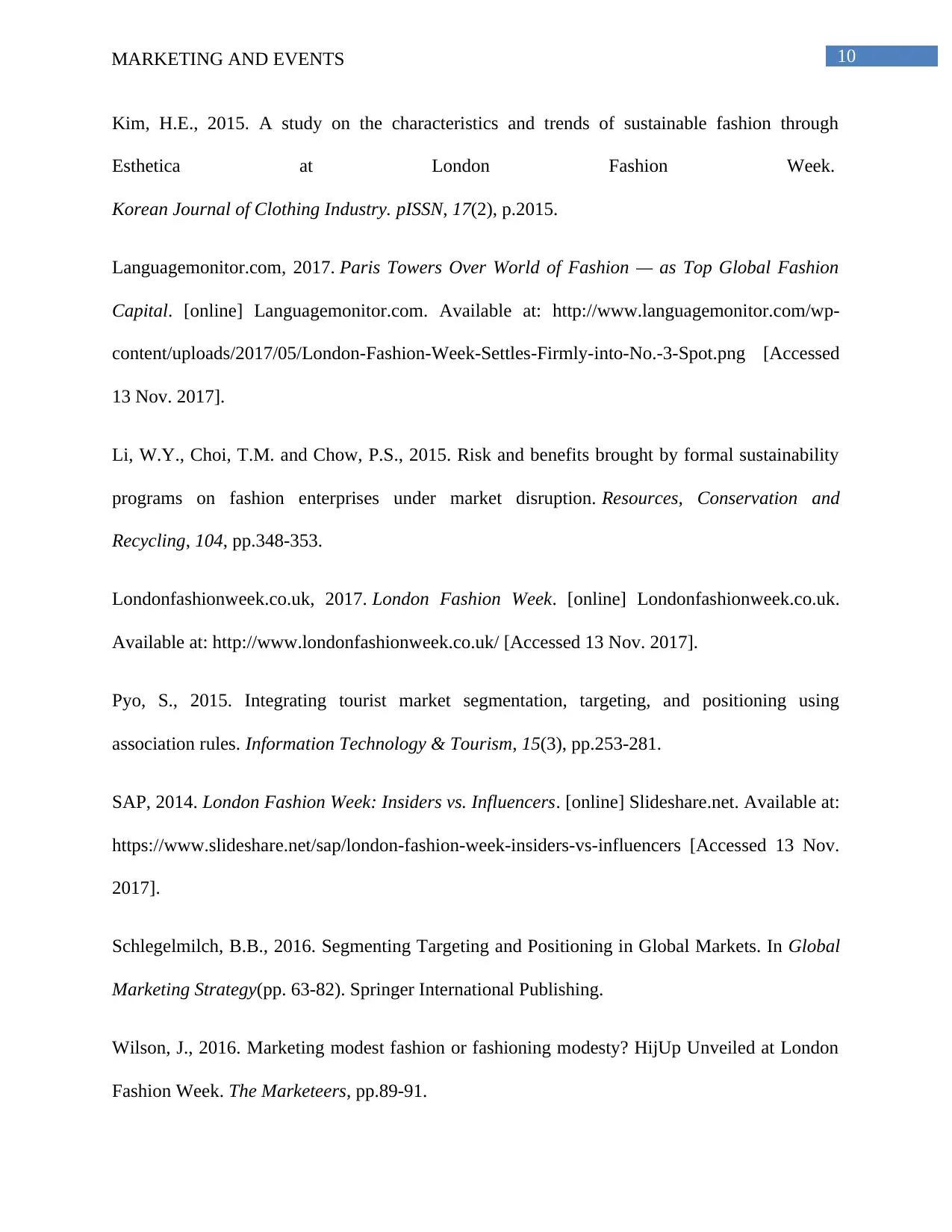
10MARKETING AND EVENTS
Kim, H.E., 2015. A study on the characteristics and trends of sustainable fashion through
Esthetica at London Fashion Week.
Korean Journal of Clothing Industry. pISSN, 17(2), p.2015.
Languagemonitor.com, 2017. Paris Towers Over World of Fashion — as Top Global Fashion
Capital. [online] Languagemonitor.com. Available at: http://www.languagemonitor.com/wp-
content/uploads/2017/05/London-Fashion-Week-Settles-Firmly-into-No.-3-Spot.png [Accessed
13 Nov. 2017].
Li, W.Y., Choi, T.M. and Chow, P.S., 2015. Risk and benefits brought by formal sustainability
programs on fashion enterprises under market disruption. Resources, Conservation and
Recycling, 104, pp.348-353.
Londonfashionweek.co.uk, 2017. London Fashion Week. [online] Londonfashionweek.co.uk.
Available at: http://www.londonfashionweek.co.uk/ [Accessed 13 Nov. 2017].
Pyo, S., 2015. Integrating tourist market segmentation, targeting, and positioning using
association rules. Information Technology & Tourism, 15(3), pp.253-281.
SAP, 2014. London Fashion Week: Insiders vs. Influencers. [online] Slideshare.net. Available at:
https://www.slideshare.net/sap/london-fashion-week-insiders-vs-influencers [Accessed 13 Nov.
2017].
Schlegelmilch, B.B., 2016. Segmenting Targeting and Positioning in Global Markets. In Global
Marketing Strategy(pp. 63-82). Springer International Publishing.
Wilson, J., 2016. Marketing modest fashion or fashioning modesty? HijUp Unveiled at London
Fashion Week. The Marketeers, pp.89-91.
Kim, H.E., 2015. A study on the characteristics and trends of sustainable fashion through
Esthetica at London Fashion Week.
Korean Journal of Clothing Industry. pISSN, 17(2), p.2015.
Languagemonitor.com, 2017. Paris Towers Over World of Fashion — as Top Global Fashion
Capital. [online] Languagemonitor.com. Available at: http://www.languagemonitor.com/wp-
content/uploads/2017/05/London-Fashion-Week-Settles-Firmly-into-No.-3-Spot.png [Accessed
13 Nov. 2017].
Li, W.Y., Choi, T.M. and Chow, P.S., 2015. Risk and benefits brought by formal sustainability
programs on fashion enterprises under market disruption. Resources, Conservation and
Recycling, 104, pp.348-353.
Londonfashionweek.co.uk, 2017. London Fashion Week. [online] Londonfashionweek.co.uk.
Available at: http://www.londonfashionweek.co.uk/ [Accessed 13 Nov. 2017].
Pyo, S., 2015. Integrating tourist market segmentation, targeting, and positioning using
association rules. Information Technology & Tourism, 15(3), pp.253-281.
SAP, 2014. London Fashion Week: Insiders vs. Influencers. [online] Slideshare.net. Available at:
https://www.slideshare.net/sap/london-fashion-week-insiders-vs-influencers [Accessed 13 Nov.
2017].
Schlegelmilch, B.B., 2016. Segmenting Targeting and Positioning in Global Markets. In Global
Marketing Strategy(pp. 63-82). Springer International Publishing.
Wilson, J., 2016. Marketing modest fashion or fashioning modesty? HijUp Unveiled at London
Fashion Week. The Marketeers, pp.89-91.
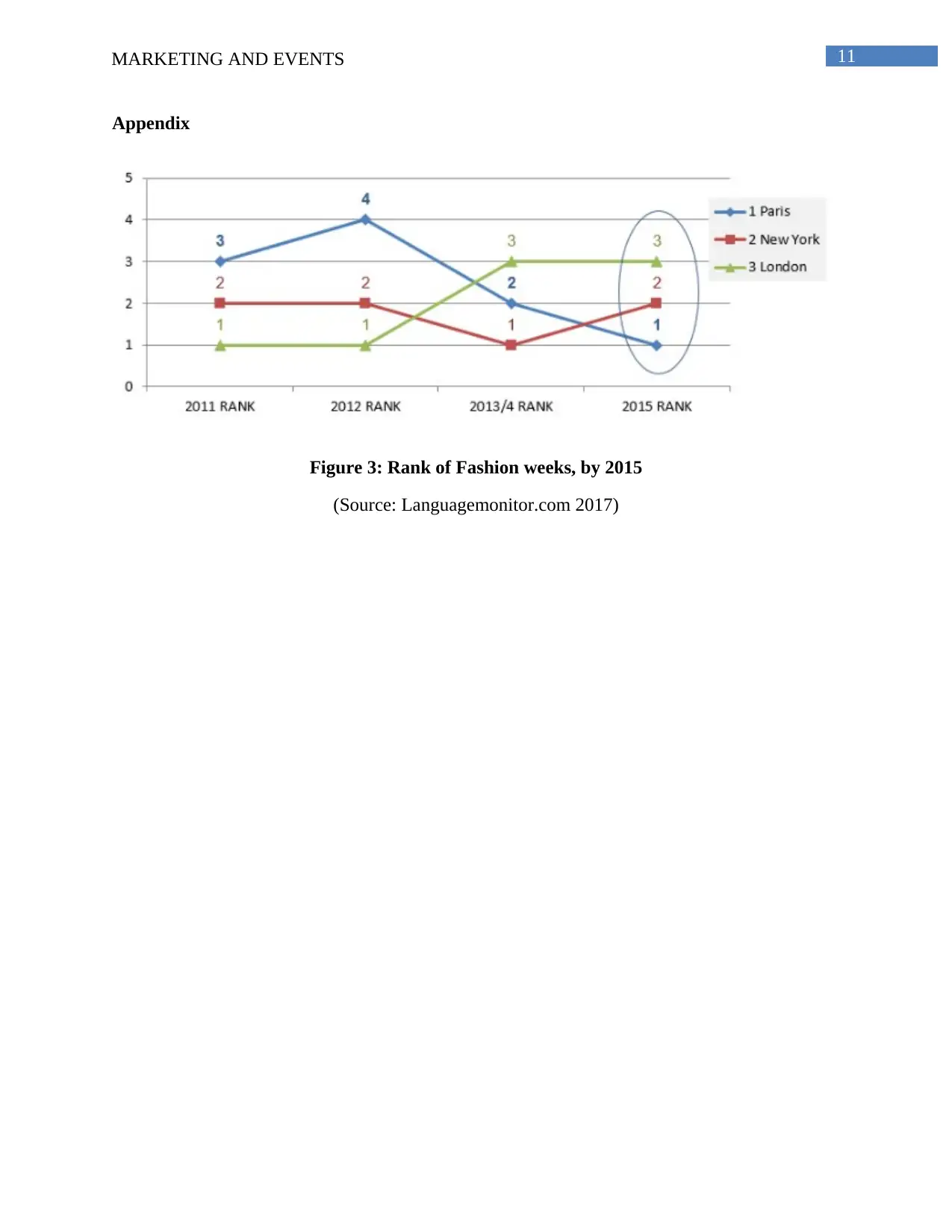
11MARKETING AND EVENTS
Appendix
Figure 3: Rank of Fashion weeks, by 2015
(Source: Languagemonitor.com 2017)
Appendix
Figure 3: Rank of Fashion weeks, by 2015
(Source: Languagemonitor.com 2017)
1 out of 12
Related Documents
Your All-in-One AI-Powered Toolkit for Academic Success.
+13062052269
info@desklib.com
Available 24*7 on WhatsApp / Email
![[object Object]](/_next/static/media/star-bottom.7253800d.svg)
Unlock your academic potential
© 2024 | Zucol Services PVT LTD | All rights reserved.





